In the article, we will consider possible malfunctions that may occur during the operation of a Renault / Dacia Sandero car.
Engine won't start
Starting an engine with a fuel injection system is the same at any ambient air and liquid temperatures in the engine cooling system.
To start the engine, you only need to turn on the starter without pressing the gas pedal, and the system will automatically adjust to the required parameters of fuel supply and ignition timing.
If the engine does not start after three attempts, then:
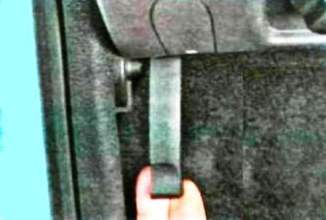
Open the hood by pulling the drive handle towards you

Measuring the oil level with a dipstick

In a K4M engine, the oil level must be between the top and bottom of the shaded area
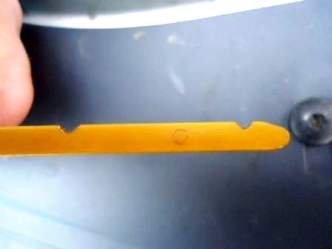
In the K7J and K7M engine - between the lower and upper marks on the dipstick
Checking the coolant level

It should be between the MIN and MAX marks on the expansion tank.
Inspecting the engine. We pay attention to the drips of gasoline, oil and coolant.
Checking the integrity of the wiring.
Check the fit of the wiring harness pads in the ignition coil connectors.
After inspecting the engine and systems, we try to start the engine again.
If the engine does not start on the first try, then press the gas pedal all the way and turn on the starter for two to three seconds.
In this mode, the cylinders are purged, fuel is not supplied through the injectors, and voltage is not applied to the spark plugs.
After purging the cylinders, we try to start the engine in normal mode without pressing the gas pedal.
If the engine still does not start, then:
- - the power system does not work;
- - the ignition system does not work;
- - the launch system does not work.
Launch problems

The starter does not turn on.
The reason may be a violation of contacts and connections.
Open circuit or short circuit in the starter switching circuits, malfunction of the traction relay.
If clicks are heard when the starter is turned on, then the cause is a discharged battery, oxidized or weak contacts on the battery or starter.
Also, the cause may be a malfunction of the holding winding of the traction relay.
If the starter turns on, but the armature either does not rotate or rotates slowly.
The reason is the battery is discharged, the contact connections are broken, the contacts of the traction relay are burnt, the collector is dirty or the brushes are worn out, interturn or short circuit in the starter windings.
When the starter is engaged, its armature rotates, but the flywheel is stationary.
The cause may be a loosening of the starter to the clutch housing, damage to the teeth of the flywheel or drive gear, slipping of the drive freewheel, breakage of the lever, driver ring or buffer spring of the starter drive.
If the starter does not turn off after starting the engine.
The reason is a malfunction of the starter freewheel, sintering of the contacts of the traction relay.
If such a malfunction occurs, you must immediately stop the engine.
Checking the ignition system
The ignition system on the car is microprocessor-based (MPS3) high energy.
Approximately 40,000 volts are converted in the ignition coils.
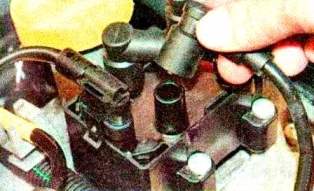
On K7J and K7M engines, with the ignition on, check the integrity and fit of the high-voltage wires in the sockets of the ignition module
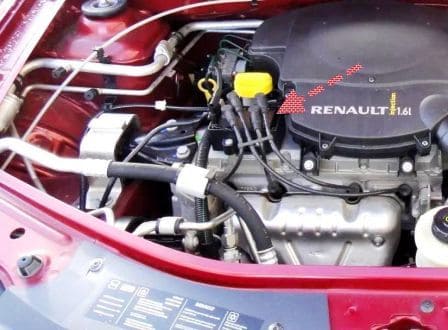
It is necessary to check the health of the ignition module
If the low voltage circuit of the ignition module is OK, check for spark at the spark plugs.
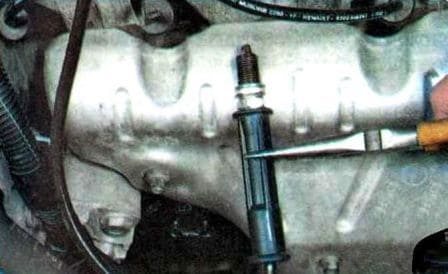
Remove the high-voltage wire from any spark plug.
We insert a spare spark plug into the wire tip and press it with the metal part to the ground.
We ask the assistant to turn the engine crankshaft with the starter.
If there is no spark, you need to replace the high-voltage wires.
On K4M engine:
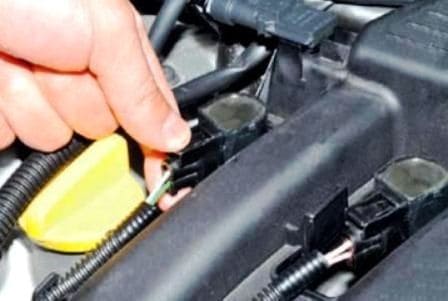
Checking the integrity and fit of the ignition coils on the candles
Checking the ignition coils. To do this, remove the coil of the first cylinder.
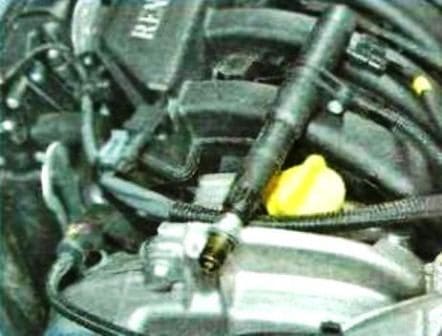
We install a checked candle into the coil and press the candle against the metal part of the engine.
An assistant cranks the engine with a starter.
A strong spark should jump between the electrodes of the candle.
If there is no spark, the ignition coil must be replaced.
In the same way, we check the remaining coils.
During this check, it is necessary that there is reliable contact of the spark plug with the ground, otherwise the engine control unit or the high-voltage circuit of the ignition coil may be damaged.
Such a check should be done no more than five seconds, so as not to damage the exhaust gas converter if unburned fuel from the engine cylinders gets into it.
If after this check the engine does not start, you need to check the engine management system.
Checking the engine power system
The main criterion for the health of the power supply system is the fuel pressure in the rail.
It is recommended to make sure the air filter is clean before this check.
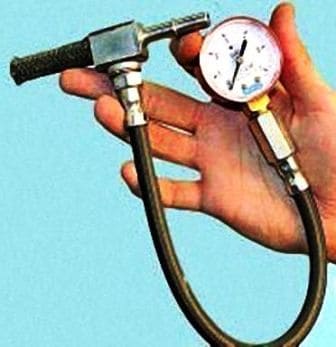
Check the fuel pressure using a pressure gauge with adapters.
With the engine idling, the pressure in the rail should be approximately 2.7 kgf / cm 2.
The following reasons for pressure drop are possible:

Fuel pump failure

Dirty fuel module strainer
It is possible to check the operation of the pump and the cleanliness of the filter only after removing the fuel module.
Faults in the fuel injection system
Cars use a multiport fuel injection system.
Spread injection is called because fuel is injected into each cylinder by a separate injector.
The fuel injection system reduces the toxicity of exhaust gases while improving driving performance and fuel efficiency of the car.
In the fuel injection system of an engine with feedback, an exhaust gas catalytic converter and two oxygen concentration sensors are installed in the exhaust system, which provide feedback.
Sensors monitor the content of kisoxygen in the exhaust gases, and the electronic control unit, according to their signals, maintains such a ratio of air and fuel at which the converter works most efficiently.
Before removing any components of the injection control system, disconnect the wire from the negative terminal of the battery.
Disconnect the battery only when the ignition is off.
Do not start the engine if the cable lugs on the battery are loose.
Never disconnect the battery from the vehicle's electrical system while the engine is running.
When charging, disconnect the battery from the car's on-board network.
Do not allow the electronic control unit (ECU) to heat up above 65 ° C in working condition and above 80 ° C in non-working condition (for example, in a drying chamber after painting).
If this temperature is exceeded, the computer must be removed from the vehicle.
Do not disconnect or connect the wiring harness connectors to the ECU while the ignition is on.
Before performing arc welding on a vehicle, disconnect the wires from the battery and the wire connectors from the ECU.
Perform all voltage measurements with a digital voltmeter with an internal resistance of at least 10 MΩ.
Electronic components used in the injection system are designed for very low voltage, so they can easily be damaged by electrostatic discharge.
To prevent ESD damage to the ECU:
- - do not touch the computer plugs or electronic components on its boards with your hands;
- - when working with a programmable read-only memory (PROM) of the control unit, do not touch the pins of the microcircuit.
When working in rainy weather, do not allow water to get on the electronic components of the fuel injection system.
Check the injection system in the following order:
- - check the ground connection of the engine and battery;
- - check pressure regulator, fuel filter and fuel pump;
- - check the fuses and relays for switching on the elements of the injection system;
- - check the reliability of the contacts of the pads with the wires of the injection system elements;
- - check the sensors of the injection system.
The vast majority of fuel injection system malfunctions are caused by the failure of the following sensors:

- crankshaft positions - complete failure of the injection system, the engine does not start;
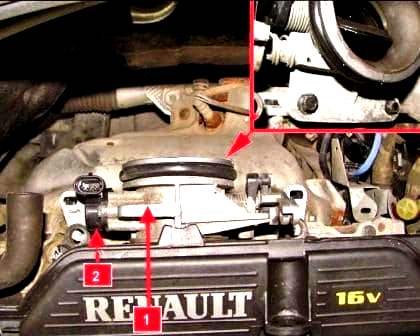
- throttle positions - loss of power, jerks and dips during acceleration, unstable idling;
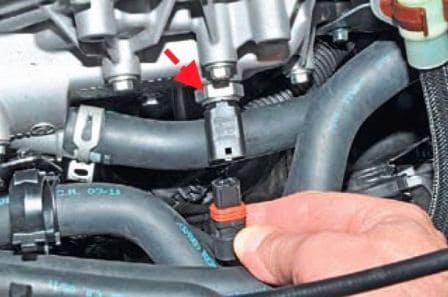
– coolant temperatures — difficulties with starting in cold weather.
We have to warm up the engine, maintaining the speed with the accelerator pedal.
When overheating, power is significantly reduced, detonation appears;
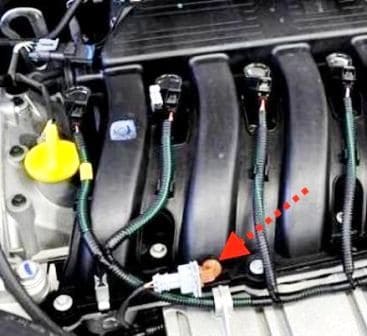
- intake air temperature sensor - if the sensor fails, it is difficult to start in cold weather, you have to warm up the engine, maintaining the speed with the gas pedal, when overheated, the engine power decreases, detonation occurs.
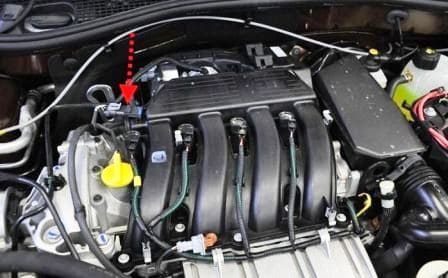
- an absolute pressure (vacuum) sensor in the intake pipe - an increase in fuel consumption, a significant deterioration in dynamics, jerks and dips, problems with starting the engine;
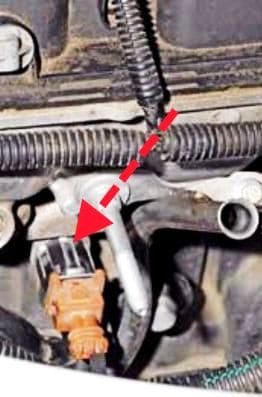
- detonation - the engine is very sensitive to the quality of gasoline, increased tendency to detonation;
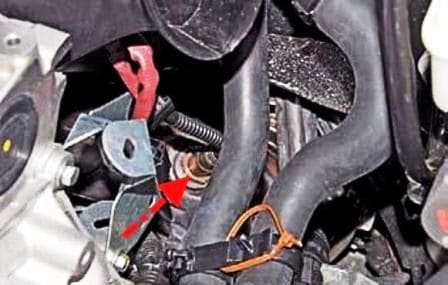
- a control oxygen concentration sensor (lambda probe) - an increase in fuel consumption, a decrease in engine power, unstable idling.
Possible catalytic converter damage;
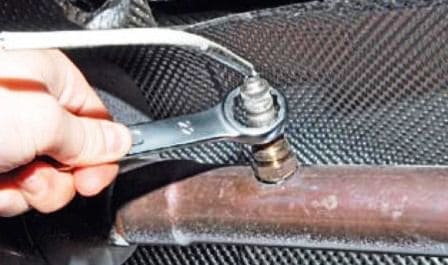
- - diagnostic oxygen concentration sensor. Catalytic converter may be damaged;
- – vehicle speed sensor

- possible deterioration of the dynamic qualities of the car in modes using maximum power (intense acceleration);
Idling lost
Special diagnostic equipment is required to determine the causes of this malfunction, so in this case, contact a service station that specializes in repairing vehicles with injection engines.
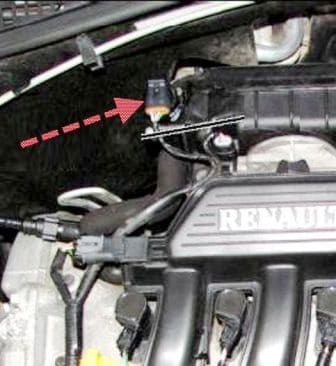
Most often, this malfunction is caused by a failure of the idle speed control or air leaks through loose connections in the throttle body hoses.
If it was not possible to restore idling by replacing the regulator and tightening the hose clamps, contact a specialist.
Engine Interruptions
In case of interruptions, the engine idles unevenly, does not develop sufficient power, and consumes gasoline excessively.
Interruptions, as a rule, are due to a malfunction of the injectors or the electric fuel pump; spark plugs of one of the cylinders, by suction of air into one of the cylinders.
You need to find the problem and fix it if possible.
Start the engine and let it idle.
Go to the exhaust pipe and listen for the sound of the exhaust.
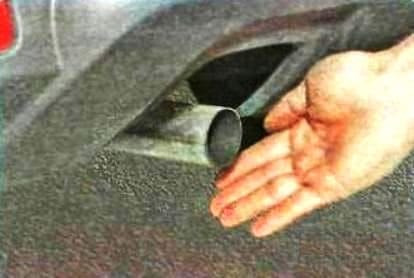
You can put your hand near the cut of the exhaust pipe - this way interruptions are felt better.
The sound should be smooth, "soft", of one tone.
Pops from the exhaust pipe at regular intervals indicate that one cylinder is not working due to a failed candle, no spark on it, a nozzle failure, a strong air leak into one cylinder or a significant decrease in compression in it .
Popping at irregular intervals is caused by dirty injector nozzles, severe wear or dirty spark plugs.
If pops occur at irregular intervals, you can try to replace the entire set of candles yourself, regardless of mileage and appearance, but it is better to do this after contacting a car service for diagnostics and repair of the engine control system.

If the popping is irregular, stop the engine and open the hood.
Check the condition of the ignition harness and the fastening of the wire blocks on the ignition coils.
If there is damage to the wires, replace the entire ignition harness.
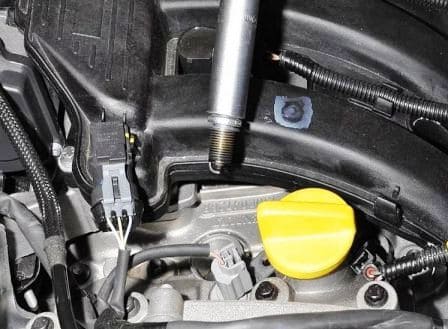
Remove the spark plugs.
Carefully inspect the candles and compare their appearance with the photos in the article below.
If all the candles lookt serviceable, install the candles and coils in place and connect the wiring harness pads to them.
Disconnect the wiring harness connector from the 1st cylinder coil.
Start the engine.
If engine interruptions do not increase, replace the spark plug in the 1st cylinder with a known good one.
Put on the high voltage wire and start the engine.
If the interruptions increase, repeat the procedure with all cylinders in sequence to identify the faulty spark plug.
If as a result of the measures taken, engine interruptions are not eliminated, check the compression in each of the cylinders.
Normal compression is more than 1.0 MPa (10 kgf / cm 2), the difference in compression values in the cylinders is more than 0.2 MPa (2 kgf / cm 2) indicates the need for engine repair.
Diagnosis by appearance of spark plugs
Normal candlestick
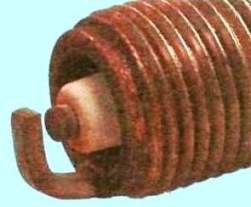
Brownish or greyish-yellowish color and slight wear on the electrodes.
Correspondence of the thermal value of the spark plug for the engine and operating conditions.
Soot deposition
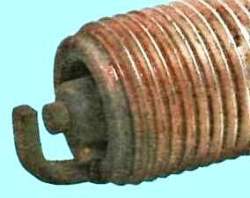
Deposition of dry soot indicates a rich mixture or late ignition.
Causes misfiring, difficult starting and erratic engine operation
Oiled electrodes and plug insulator

The reason is oil getting into the combustion chamber.
Oil enters the combustion chamber through valve guides or piston rings.
Causes difficult starting, misfiring of the cylinder and twitching of the running engine.
Tip.
Make the necessary repairs to the cylinder head and piston group of the engine.
Replace spark plugs.
Metal Plaque
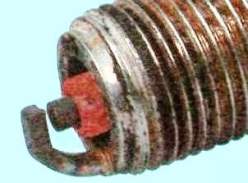
Deposition on the skirt of the insulator of brownish-red iron oxides from antiknock iron-containing additives (ferrocenes) to gasoline.
They are deposited in an even, dense layer.
When the engine is running under a heavy load with high temperature and pressure in the combustion chamber, the oxides are converted into conductive paths of pure iron, closing the central electrode to ground.
This causes misfiring, a drop in engine power.
This can damage the catalytic converter.
The plaque is practically not removed mechanically and does not burn out when driving at high speed.
If it is not possible to immediately replace with new candles, then we put the candle in a rust converter, after that we clean the candle with a metal brush, rinse with water, and then with gasoline.
Molted electrodes
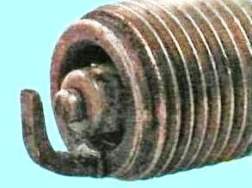
Early ignition. The insulator is white, but may be contaminated by sparks and deposits from the combustion chamber.
May cause engine damage.
It is necessary to check the type of spark plug, the cleanliness of the injector nozzles and the fuel filter, the operation of the cooling and lubrication system.
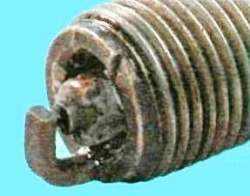
Cracked or chipped insulator
Damage caused by detonation.
May damage the piston.
Occurs when the knock sensor is faulty.
Make sure that the gasoline meets the requirements.
Mechanical damage on the candle
Damage can be caused by foreign objects entering the combustion chamber, and if a spark plug with a long skirt is used, its electrodes can catch on the piston.
Remove foreign item and replace the candle.
The car moves jerkily
In relation to a car, a jerk is a short-term spontaneous change in the engine speed, regardless of the position of the accelerator pedal.
In everyday use, as a rule, there are a series of jerks.
The limiting case of a jerk is a dip - a perceptible delay in the response of the engine to pressing the accelerator pedal.
Three types of jerks can be conditionally distinguished:
- – at the moment of the beginning of the movement;
- – during overclocking;
- – with steady motion, i.e. at a constant position of the accelerator pedal.
To determine the causes of jerks when driving a car with an injection engine, special diagnostic equipment is required, so in this case we recommend contacting a service that specializes in repairing fuel injection systems.
However, as practice shows, in most cases, jerks are caused by insufficient fuel pressure in the fuel rail, malfunctions of the throttle position sensor.
If you have some skills, you can determine the cause of jerks yourself.
Jerk at the start of the movement
At the moment of the beginning of the movement, most often there is an extreme case of a jerk - a failure.
The most unpleasant sensations are associated precisely with the delay in the response of the engine to pressing the accelerator pedal.
Sometimes the engine will even stall.
A jerk occurs at the moment the throttle valve starts to open, when, according to the signal from the throttle position sensor, the ECU determines the moment of transition from idle to load mode and should increase the amount of fuel supplied through the injectors.
If there is insufficient pressure in the fuel line (even with an increase in the duration of injection), there is not enough fuel for a smooth start.
Jerking during acceleration
The cause of jerks during acceleration may be, as in the previous case, insufficient fuel pressure in the fuel line.
The electronic engine control unit, having received a signal from the throttle position sensor about the intensive opening of the damper at a large angle, seeks to maximize the fuel supply, but is unable to do this due to low fuel pressure.
The reasons for this phenomenon and the method of verification are the same as in the previous case.
Jerking while moving
Such jerks are most often caused by a malfunction of the ignition system.
Requires diagnostics and repair.
On the road, you can try the following yourself:
- carefully inspect the engine compartment.

Turn off the ignition and check that the wire harness connectors are securely fastened to the ignition coils.
Start the engine and listen to its work: crackling during the breakdown of high voltage "to ground" is weak, but distinct.
In complete darkness, a spark is clearly visible during breakdown;
- Replace the spark plugs regardless of their condition and mileage.
Pay attention to the condition of the spark plugs: if they are abnormal, the engine or its systems may need to be repaired.

A specific cause of jerks during the steady movement of a car with an injection engine may be a failure of the throttle position sensor.
Additional symptoms confirming the malfunction of this sensor are:
- - uneven engine idling;
- – reduction of the maximum engine power.
The sensor is non-separable and therefore not repairable.
If a sensor malfunction is detected, it is replaced as an assembly.
The car does not accelerate well
There are many reasons for the deterioration of dynamics, the main ones can be defined as follows.
Engine malfunction: reduced compression in one or more cylinders, additional air leaking into the engine intake tract.
Coking of the exhaust system or damage to the exhaust gas converter.
Faulty power system: clogged injectors and fuel filter, hoses of the fuel supply system.
Insufficient fuel pump supply.
Use of low-quality fuel.
Ignition system malfunction: failure of the spark plug, breakdown of the high-voltage circuit of the system.
Malfunction of the engine management system: failure of the system sensors.
If any sensor fails, the electronic control unit will switch goes to work under a backup program that allows you to get to a garage or car service, but at the same time, the power and economic characteristics of the engine are reduced.
Clutch slip due to wear or misadjustment.
Brake system malfunction: braking of one or more wheels while driving, incorrect adjustment of the parking brake.
Insufficient tire pressure.
Car overload.
Complete car diagnostics should be carried out by highly qualified craftsmen using special diagnostic equipment, so contact a car service.
You can do the following work yourself:
Check and correct the air pressure in the tires.
Check the operation of the service brake system and the parking brake.
It is not necessary to remove the wheels for this.
Find a flat stretch of road and, in dry, calm weather, run a drive to determine the run-out of the car.
The car must be fully fueled, only the driver is in the cabin.
Accelerate the car to 50 km/h, level off the speed, and then disengage the gear and coast to a stop.
Perform another run in the opposite direction.
The overrun should be about 500 m.
Check the ignition system as described above.
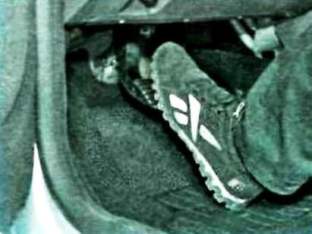
Check the operation of the clutch of a car with a manual transmission.
The initial check is carried out on a flat, obstacle-free area.
Set the accelerator pedal to a high idle speed - approximately 1500 min -1
Put the parking brake on the car.
Depress the clutch and shift into first gear.
Then start to slowly release the clutch pedal.
If the engine stalls, the clutch is working and not slipping.
If the engine does not stall, the clutch is worn out, you need to replace it or adjust the drive.
Check the engine management system.
Engine stalled while driving
Sooner or later, every driver can find himself in a situation where the car, which a few moments ago obeyed all commands, suddenly stops responding to pressing the accelerator pedal, and red lights light up on the dashboard.
The engine has stopped working, the car is losing speed. What to do in such a situation?
Most importantly, don't be nervous! Turn on the hazard warning lights, depress the clutch pedal and, using the momentum of the car, try to carefully move to the edge of the roadway and stop as far to the right as possible at the curb, and if possible, outside the roadway.
Please note that when the engine is not running, the effectiveness of the vehicle's braking system is reduced, so more force on the brake pedal may be required to stop.
Set the parking brake.
If the vehicle is stopped on a slope, use the wheel chocks.
In difficult traffic conditions and on country roads, set an emergency stop sign, as provided for by the Rules of the Road.
Now you need to find out and fix the problem.
There are two main reasons:
- – the ignition system does not work;
- – the power system is not working.
First, determine if there is gasoline in the tank. Turn on the ignition and look at the fuel gauge.
If the yellow fuel reserve warning light is off and the gauge needle shows fuel, it can be assumed that there is gasoline in the tank.
Open the hood and carefully inspect the engine compartment. Pay attention to the integrity of all units.
Check if all the wires are in place, if there are broken, burned out, damaged insulation.
Inspect the petrol hoses, engine fuel line and fuel filter for any leaks of petrol.
If gasoline leaks, in no case do not start the engine until the malfunction is completely eliminated!
Inspect the expansion tank of the cooling system for leaks of coolant.
Check also the oil level in the crankcase. If everything is in order, proceed to check the ignition and power systems described earlier, but first check the condition of the timing belt.
If the belt is broken, the engine will not start for no apparent reason.
Oil pressure dropped
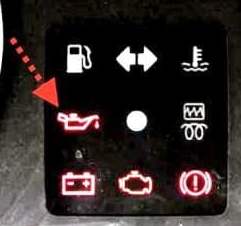
In the instrument cluster of the car there is a warning light for an emergency drop in engine oil pressure.
For reliable operation of the engine, it is necessary that a sufficiently high pressure is constantly provided in the lubrication system.
If the emergency oil pressure drop warning light comes on when the engine is running and remains on at an increased speed, this is a warning sign.
We must immediately stop driving, stop the engine and find out the cause.
Further operation of the engine with reduced oil pressure can lead to serious damage to it and high financial costs for repairs.
Open the hood. Do not rush to immediately check the engine oil level, let it drain into the oil sump, this will take two to three minutes.
During this time, carefully inspect the engine, find out if there are any fresh oil leaks on it.
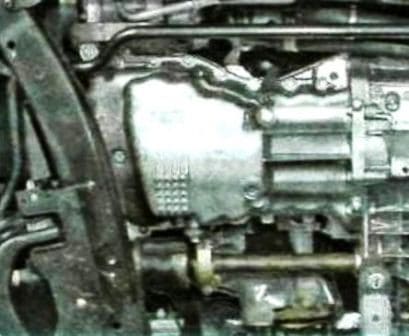
Look under the front of the car - if the engine oil sump is broken, if there is a leak.
If an oil leak is detected from a punctured oil sump, try to temporarily fix it in place.
To do this, you can use a car camera, a piece of rubber, a rag, a wooden cork, etc.
The use of modern repair materials such as "cold welding" available in car dealerships can give a good result.

Pay special attention to the oil filter.
Oil may leak from under the filter's rubber seal if it is damaged or the filter is loose.
If oil is leaking from under the oil filter, sometimes it is enough to turn it a little clockwise.
Be careful, hot engine parts can burn you, so wear gloves and long sleeves.
If the oil level is below the lower mark on the scale, top up the oil to the correct level.
Start the engine. If the emergency oil pressure drop lamp goes out at a normal level, you can continue driving.
If the lamp does not go out, check the oil pressure sensor.
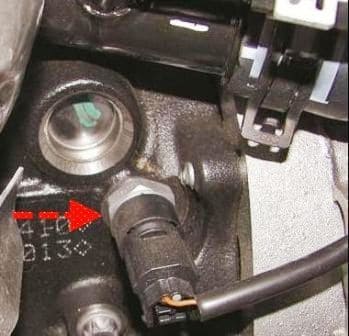
It is installed on the side of the cylinder block facing the radiator of the cooling system.
Remove the stock oil pressure sensor and install a mechanical pressure gauge in its place.
If at normal idle speed the pressure is more than 0.06 MPa (0.65 kgf / cm 2) and increases with increasing speed, the sensor or its electrical circuit is faulty.
If you do not have a pressure gauge, all that remains is to check the reliability of the contact in the block with the sensor wires or replace the sensor with a known good one.
If, after eliminating all visible causes, the oil pressure in the engine is not enough (the emergency oil pressure drop lamp is on), diagnose and repair the engine.
Engine overheating
A malfunction in the cooling system can cause the engine to overheat.
If you miss the moment of engine overheating, you may experience:
- - breakdown of the cylinder head gasket;
- - warp head.
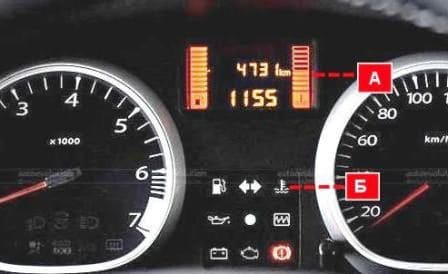
In the instrument cluster there is an indicator "A" for the temperature of the coolant and a signal lamp "B" for engine overheating.
If the engine overheats, the indicator scale will be completely shaded (at normal temperature, the four lower divisions of the scale are shaded) and the warning lamp will light up.
Checking the cooling system
At the first sign of overheating, if the indicator scale is completely shaded, but no vapors escape from under the hood, you need to turn on the maximum mode of the interior heater to reduce the temperature of the coolant.
Do not stop the engine immediately unless there is a fluid leak from a broken hose or another leak.
Stop the engine.
Open the hood and locate the fluid leak.
Look under the floor mats of the front pass soot and determine if there is any leaking liquid from the heater radiator under them.
If there is no antifreeze during the trip, then you can simply add water. Do not add cold water to an overheated engine.
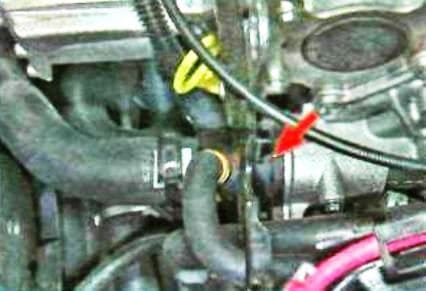
The engine may overheat if the thermostat fails.
To check the thermostat, on a warm engine, feel the temperature of the lower hose connecting the radiator to the engine.
If the lower hose is cold, the thermostat is defective and there is no fluid circulation through the radiator.
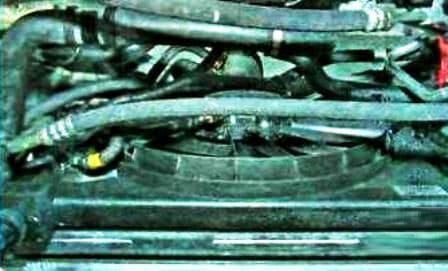
Fan motor failure is often the cause of motor overheating
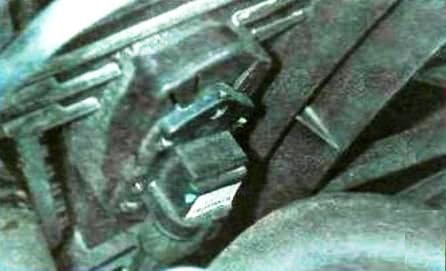
Start the engine, monitor the temperature and see if the cooling fan turns on when the engine overheats.
If it does not turn on, the cause may be a faulty auxiliary resistor, a blown fuse, a faulty turn-on relay, oxidized contacts in the wiring harness block, or a burnt motor.
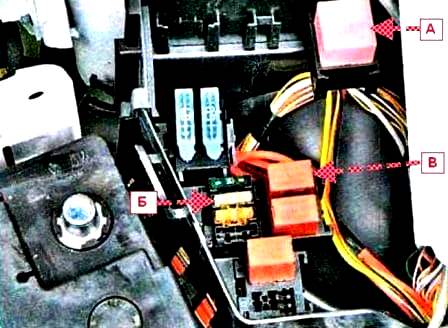
We replace the fuse "B" in the mounting block, in the engine compartment.
If the fan does not work after replacing the fuse, replace relays "A" and "B".
If after these manipulations the electric fan does not work, we check the fan motor.
To do this, we connect the wires directly to the electric motor and to the battery.
If the electric motor starts to work, then the wiring is faulty.
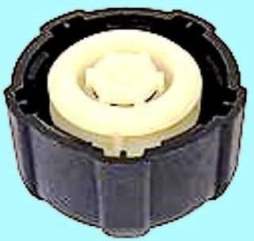
An important role in ensuring optimal temperature conditions is played by the expansion tank plug valve.
It maintains an excess pressure of at least 0.15 MPa (1.5 kgf / cm 2) in the system.
In this case, the boiling point of water rises to 120 ° C, and antifreeze to 130 ° C.
When the valve is stuck in the closed position during overheating, a significant overpressure [more than 0.2 MPa (2 kgf / cm 2)] occurs, which can lead to a rupture of the expansion tank or a breakdown of one of the hoses .
Once a year, wash the radiator cells with a high-pressure water jet (on a special washer), directing the jet first towards the oncoming air flow, and then in its direction to remove dirt, insects and road debris from the surface of the radiator.
This partially restores the efficiency of the heatsink.
Battery not charging
There are two power sources on the car - a battery and a generator.
The battery is used when starting the engine and to supply 12 V electric current to the starter and other consumers when the engine is not running.
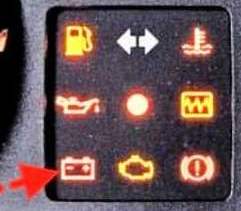
When the engine is running, the main current source - the generator - provides electric current to all consumers, including the ignition system, and charges the battery.
If the red battery charging lamp is on on the dashboard, it means that the current is not supplied from the generator to the on-board network and the battery energy is consumed.
This supply is limited and varies by capacity. If the battery has been fully charged, you can drive to the garage without a generator, but it is better to try to fix the problem on the spot.
Checking electrical equipment
Check if the auxiliary drive belt is broken.
If the belt breaks, replace it.
If the belt is intact, check we cut and, if necessary, adjust its tension.
We press on the belt branch with our thumb, if the distance between the centers of the pulleys is 180-400 mm, the deflection should be approximately 6 mm, and if the distance is 300-400 mm, the deflection should be 13 mm.

If after checking the belt tension the warning light is still on, check the wires connected to the "+" terminal of the battery.
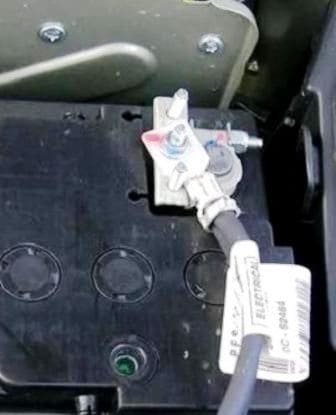
Checking the wires connected to the "-" terminal of the battery

Checking the wires connected to the starter and to the generator
If, after the measures taken, the charging lamp is still on, then the malfunction is in the generator itself.
Engine knocks
If you think that the engine sounds that were not there before, immediately check if everything is in order with the engine.
Most often, engine knocks are associated with serious malfunctions, for diagnosing and eliminating which you will have to disassemble the engine in a service or garage.
You can try to determine the cause of the knocks yourself in order to decide whether to go to the car service on your own or in tow.
If you have the slightest doubt about the results of self-diagnosis, get the towline.
Serious repair of a damaged engine will cost more than a towing service.
Knock of main bearings - very dangerous; stop the engine immediately, you will have to go to the car service or garage in tow.
A low-pitched knock. It is audible in the lower part of the crankcase, noticeably increases under load and with an increase in speed.
Often, its appearance is accompanied by a drop in oil pressure (the emergency oil pressure drop lamp is on almost constantly).
The knock of connecting rod bearingsin is very dangerous; stop the engine immediately, you will have to go to the car service or garage in tow.
The sound is rhythmic, sonorous, metallic, of medium tone. Increases significantly with increasing load and completely disappears when the spark plug is turned off.
The sound of piston pins is dangerous; without loading the engine, you can drive to a car service or garage on your own.
Rhythmic, high tone with a sharp metallic tint, audible in all engine operating modes and intensifies with increasing engine load.
Completely disappears when the spark plug is disconnected.
The sound of worn pistons and cylinders is harmless; without heavily loading the engine, you can drive to a car service or garage on your own.
A sound reminiscent of the clatter of pottery. It is especially audible on a cold engine, decreases or disappears as it warms up.
Valve knock - not dangerous; you can drive to a car service or garage on your own.
Metal clatter against the background of a general muffled noise.
It is well audible at low and medium speeds of the crankshaft from the side of the cylinder head above the valve locations.
Knock knocks are dangerous; avoiding a strong engine load, you can drive to a car service or garage on your own.
Voiceful metallic knocks that occur, as a rule, during acceleration of the car.
The reason is a malfunction of the knock sensor, the use of low-octane fuel, engine overload with too early upshift, significant carbon formation in the combustion chambers.
It is necessary to choose the right gear depending on driving conditions, refuel with gasoline with an octane rating recommended by the car manufacturer, check the knock sensor, apply a special fuel additive to remove carbon deposits on valves and in combustion chambers.
Knocks in the suspension and transmission
If extraneous knocks appear in the suspension of a moving car, it is necessary to immediately establish their source, regardless of whether it is a constant knock or appears only when driving through bumps.
Check the suspension.
It is better to check the condition of the suspension by installing the car on a flyover, inspection ditch or lift, and if this is not possible, you can do this work, hocha and with less amenities, on a free flat area. In any case, you will need an assistant.
It is quite difficult to diagnose the health of transmission units by the noise they emit.
If you are unable to pinpoint the source of the noise, contact a qualified technician.
Repair or replace failed suspension units
The cause of knocks from below can be malfunctions of not only the suspension, but also the steering of the car.
The state of the steering to a large extent affects not only the convenience of driving, but also the safety of traffic.
The cause of knocks and vibrations on the steering wheel may be a faulty condition of the ball joints of the steering rods and the steering mechanism, the wheels of the car.
Check the steering.
A possible cause of vibration and impact on the steering wheel when driving at a speed of more than 70-80 km/h may be an imbalance of the front wheels.
Contact a car service or tire shop to check the front wheel balance.
If shock and vibration on the steering wheel appear at the moment you press the brake pedal, you need to replace the brake pads, repair or replace the front brake discs.
Suspension knocks, causes and remedies
Cause of malfunction - Remedy
Shock absorbers defective - Replace or repair shock absorbers
Loosen the bolts and nuts of the front suspension anti-roll bar;
wear of pillows and rubber-metal rods - Tighten the rod fastenings, replace worn pillows
Damage, deformation of rubber-metal hinges, upper shock absorber bearings - Replace hinges, upper bearings
Worn front control arm ball joints - Replace ball joints
Increased play in the front wheel bearings - Replace the bearing
Great wheel imbalance - Balance the wheels
Wheel rim warped - Replace rim
Suspension spring settling or failure - Replace spring
Wear of rubber-metal joints (silent blocks) of rear suspension arms - Replace rubber-metal joints
Knock from suspension breakdown due to destruction of compression buffers - Replace damaged buffers
Frequent breakdowns of the rear suspension due to rear axle overload - Avoid overloading
Possible transmission knocks, causes and remedies
Cause of malfunction - Remedy
Clutch disengaged noise
Release bearing wear or lack of lubrication - Replace bearing
Clutch noise
Deformation or failure of driven disc parts - Replace driven disc
Noise in gearbox
Insufficient gearbox oil level - Check oil level and top up
Worn or broken bearings or gears - Replace damaged parts
Noise when shifting gears
Incomplete clutch release - Adjust the clutch release actuator
Synchronizer wear - Replace worn parts
Knocking at the beginning of the car
CV joint wear - Replace defective joints
Increased final drive gear mesh clearance - Adjust clearance
Knocking, clicks when the car moves in a turn
Worn outer CV joints - Replace defective joints
Causes of bumps on the steering wheel and remedies
Increased clearance in front wheel bearings - Replace bearings
Loosen tie rod ball stud nuts - Tighten nuts
Increased clearance in tie rod ball joints - Replace tie rod ends
Increased steering clearance - Repair steering gear
Loose steering gear - Tighten steering gear





